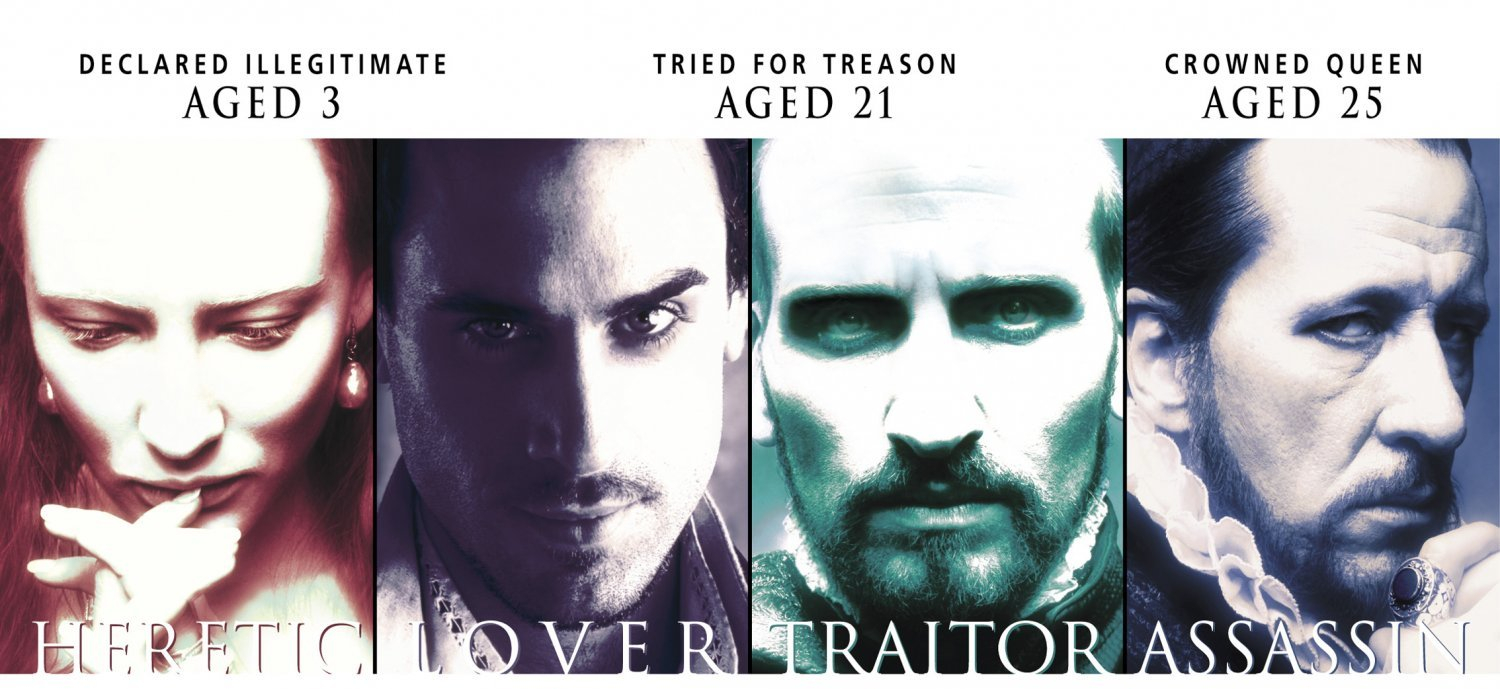A long, long time ago, I wrote that it would take too long to detail the very many historical inaccuracies present in Elizabeth (1998) and as I recently found my copy of it and have a mighty need to throw it away, that particular article just begged to be written.
Described by reviewers as an “extravagant history lesson,” a “thought-provoking history lesson,” while the screenwriter assures us in the ‘Making of…‘ that much of the plot is based on historical events (though embellished slightly for entertainment’s sake) we would assume then that Elizabeth is a largely accurate portrait with some exaggeration. Instead, we have a two-hour drama in which Elizabeth is the only Protestant in England and Robert Dudley a traitor in the pay of Spain (to say the least).
At the centre of the film is the question – why was Elizabeth the Virgin Queen? Why did she feel the need to invent herself as Gloriana and maintain that image so strictly? On one hand, it could be that the ravages of illness and age combined with her natural vanity served her to fall into presenting a pre-conceived image of ‘the virgin queen’ to the nation, in order to disguise her emerging physical flaws. On the other, it could be that she slept with Robert Dudley, regretted it and then endeavoured to “reclaim her lost virginity from a man who wasn’t worthy of it.” Yup, I’m not making that up – that’s a quote from the director.
Mary I
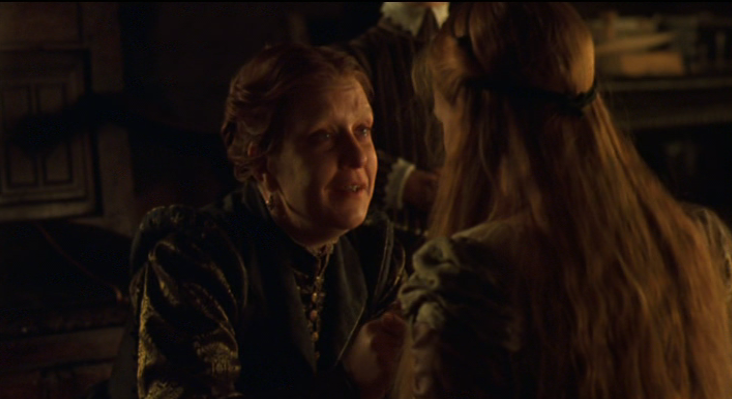
The Film: Mary I rules with an iron fist, comfortable in the loyalty of her subjects who see her as the true ruler for her efforts in restoring the Catholic faith, despite her evident mental instability. Her husband is obviously disinterested in her and everyone knows it. When she falls pregnant, everyone knows that this is impossible and they start preparing for her death. An increasingly unstable Mary believes that their description of her condition as ‘a tumour’ is a result of poisoning which has killed her baby in an attempt to make Elizabeth queen. She refers to Elizabeth as the bastard child of the whore, Anne Boleyn, holding considerable enmity against her half-sister for Boleyn’s actions. Mary’s condition worsens causing the Protestant exiles to return from abroad, Philip abandons her and makes a proposal to Elizabeth via the ambassador, de la Quadra and Norfolk attempts to get Mary to sign Elizabeth’s execution warrant on her deathbed.
In History: Mary’s marriage was an unhappy one, as her husband viewed it as a little more than a political arrangement. However, there was no reason to believe that Mary was not pregnant on the two occasions it appeared she was. Although these turned out to be phantom pregnancies, doctors did not diagnose either pregnancy as a tumour and Mary did not believe that her baby had been poisoned. Her second false pregnancy was later revealed to be a tumour of some kind but that was with the benefit of hindsight and contemporaries were not preparing for her imminent death. The exiles did not return until Elizabeth was safely on the throne and neither was Philip making overtures to Elizabeth, though he did offer his hand after she acceded to continue the alliance began in Mary’s reign.
Thomas Howard, Duke of Norfolk
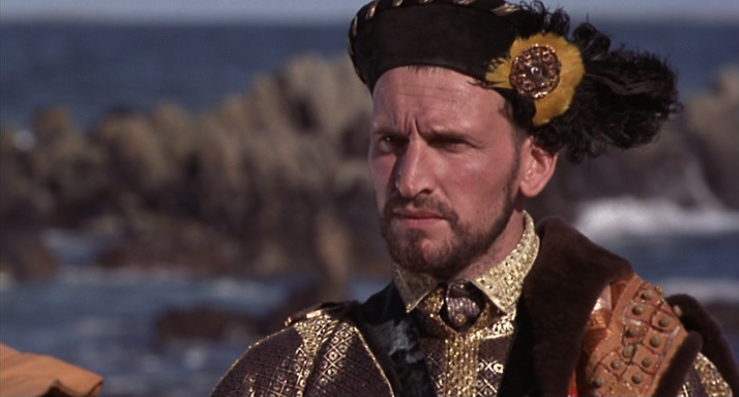
The Film: From the offset, Norfolk sets himself up as a rival claimant to Elizabeth’s throne. He is openly hostile towards her, yet remains the most powerful man at court simply because he is the Duke of Norfolk. He embroils himself in numerous plots against Elizabeth, aligning himself with every faction that has an interest in displacing her. He works with King Philip via de la Quadra to put himself on the throne with the support of the Pope. Unbeknownst to Philip (officially at least), the Pope has also approved of Norfolk’s secret arrangement with Mary, Queen of Scots, to marry her in order to further legitimise his claim to the throne. Although his schemes are relatively well known it is not until he signs a letter confirming his intentions that he is arrested for treason, which he welcomes as a Catholic martyr.
In History: As a natural claimant to the throne, the Duke of Norfolk was a potential rival to Elizabeth, but as her cousin and the premier Duke he held great public office. He did not set himself up as a rival king but did spend a stint in prison when Elizabeth discovered he had been planning to marry Mary, Queen of Scots. Upon his release, he was embroiled in another plot to dethrone the Queen and this time he was executed. Although his family was traditionally Catholic, Norfolk was a Protestant and was likely only involved in a Catholic conspiracy because of the power it would afford him rather than his conviction of religion.
William Cecil
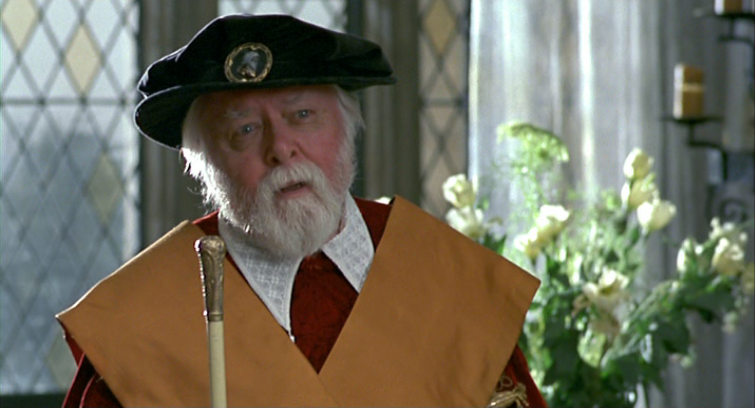
The Film: William Cecil is an elderly man who supports Elizabeth even under Mary’s reign. To this end, he meets with her in secret and works to arrange her marriage to King Philip, though Mary still lives. Elizabeth relies on his advice and guidance as she doesn’t quite understand court intrigue, but she ignores his advice on marriage – first to the Spanish and then to the French, eventually forcing him into retirement as Lord Burghley so that England may exist independently of foreign powers.
In History: William Cecil was not all that much older than Elizabeth, and certainly wasn’t an elderly man in her service. Although his support for her was kept in secret, he did not need to meet with her clandestinely as he had a legitimate reason to meet with her as the administrator of her lands. He was made Secretary of State upon Elizabeth’s accession, but though he proved to be one of her most faithful advisors Elizabeth was far from ignorant of the ways of court. His foreign policy favoured Protestant countries, and he remained at the Queen’s side for the rest of his life. His creation as Lord Burghley wasn’t for his retirement and the following year he was given more power at court as Lord Treasurer.
Francis Walsingham
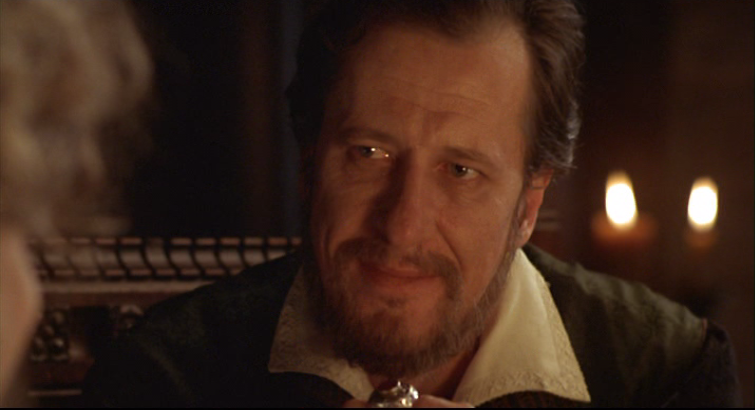
The Film: Having gone into exile under Mary’s reign, Walsingham, an atheist, is feared by the Catholics at home and Norfolk goes as far as to send an assassin to kill him before he can return to England. Walsingham kills the assassin, returns and is appointed as Elizabeth’s personal bodyguard by Cecil. In this role, he eliminates her political opponents, imprisons those who would vote against her in Parliament to ensure her legislation passes and assassinates Mary of Guise. Unlike the rest of the Queen’s councillors who want to see Elizabeth married, Walsingham imagines a strong England united under Elizabeth as an unattached ruler emulating the divine on earth. This culminates in his advice to her to become Gloriana, replacing the Virgin Mary on earth and uniting England. He weeps when Elizabeth enters the court dressed as the iconic Virgin Queen.
In History: Walsingham had indeed gone into exile, as had many other Protestants, upon the accession of Mary I, however, he was staunchly Protestant rather than an atheist, (which was also punishable by death). Upon his return, he acted as a minor politician for many years before coming to the attention of William Cecil about ten years into Elizabeth’s reign. As a spymaster, he did dissolve numerous plots against the Queen, including one that saw the execution of Norfolk, but he was not her personal bodyguard, likely had little to do with the cult of Gloriana and certainly didn’t murder Mary of Guise while having sex with her.
Mary of Guise

The Film: Mary of Guise is living in Scotland and has garrisoned the Scottish border with French troops to antagonise the English. She later increases the garrison by at least four thousand troops in preparation for a pre-emptive attack against England which has no standing army, navy, munitions and no buildings able to withstand an assault. When Elizabeth agrees to the Privy Council’s demands that they meet this declaration of war head-on, she orders the army North. The bishops subvert her order and instead of an army, children and boys are sent. Mary of Guise appears on the battlefield in person, wearing armour and apparently having engaged in the fighting herself. She sends an injured boy back with a message, “tell that bastard queen not to send children to fight Mary of Guise,” suggesting a long tradition of battle. Victorious in the war, she backs off while Elizabeth entertains the suit of her nephew, Henry of Anjou. When that falls through she arranges the delivery of a poisoned dress to Elizabeth, but her plot is uncovered when one of the Queen’s ladies wears it instead. After this Walsingham visits, seduces and assassinates her in plain sight, in front of her servants and Henry of Anjou.
In History: At the time of Elizabeth’s accession, Mary of Guise was regent in Scotland for her sixteen-year-old daughter, Mary, Queen of Scots. Her Catholicism brought her into conflict with the heavily Protestant lords of Scotland, and eventually, there was open rebellion against her. Instead of a war between England and France fought in Scotland, Elizabeth sent military aid to the Protestant rebels, in accordance with a treaty she had drawn up with the Scottish lords. Mary herself was praised for her courage and conduct, and the rebels were successfully repelled from Leith Castle but after suffering heavy losses. Soon after however, Mary of Guise fell suddenly ill (without intervention from Francis Walsingham) and did not recover; she died of dropsy after a brief illness.
Henry, Duke of Anjou
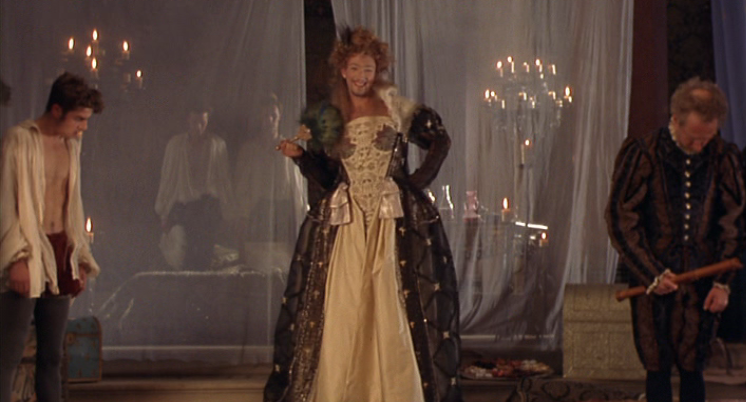
The Film: Upon Elizabeth’s accession, the French ambassador offers her greetings from the King of France who offers his brother, Henry of Anjou as a potential husband. After Mary of Guise defeats the English army in Scotland, France offers to make peace with Elizabeth on the condition that she accepts Anjou as a suitor. Anjou arrives in England posing as a musician so that he may surprise Elizabeth. He is shown to be an exuberant prankster who publicly embarrasses the French ambassador and the Queen when he kisses her without permission and speaks lewdly to her in front of the court. Later, when Elizabeth seeks him out to decline his suit she finds him dressed as a woman, in bed with two gentlemen, presiding over a bisexual orgy. Instead of France, he returns to Scotland where it is insinuated he is having an affair with his aunt, Mary of Guise, and is distraught when Walsingham murders her.
In History: Henry, the Duke of Anjou was offered as a candidate for Elizabeth’s hand in the early years of her reign. However, he never came to England and was known for being openly critical of her. He was possibly bisexual, keeping a number of mistresses but having rumoured affairs with some of his male friends. Rumours of his sexuality and effeminate conduct may just have come from his political enemies, but either way, it is unlikely he had much interaction with his aunt, Mary of Guise.
The Plots and the Purge
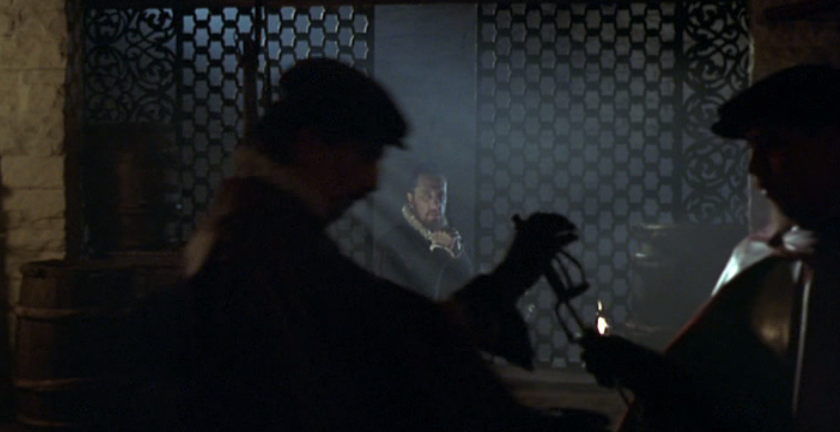
The Film: Almost every major player in Europe is conspiring to have Elizabeth removed from the throne. Mary, Queen of Scots declares herself Queen of England after Mary I’s death and conspires with the Duke of Norfolk to remove Elizabeth. The French apparently support Mary of Guise’s military incursions into England from Scotland but also hope for Anjou’s success allowing France to control England through marriage. Likewise, The King of Spain proposes to Elizabeth before Mary I has even died and continues his pursuit, while also conspiring with Norfolk to see him as a Catholic king, seemingly unaware of Norfolk’s schemes with the Queen of Scotland. The Pope and all Catholics oppose Elizabeth with Jesuit priests arriving to assassinate her. The Pope issues a papal bull of excommunication inviting English Catholics to overthrow Elizabeth to assure their place in heaven. Meanwhile, the English bishops oppose and subvert Elizabeth’s rule at every opportunity, led by Bishop Gardiner who attained prominence under Mary I.
As the Queen’s bodyguard, Walsingham takes it upon himself to protect Elizabeth from these threats. This culminates in a purge of her political opponents where his men troop through the castle and kill all those implicated in the major plot against her. The Earl of Sussex is killed on the toilet, the Spanish ambassador dies while sitting at a table, Bishop Gardiner is run through while at prayer, the Earl of Arundel is discovered taking mass with a Jesuit priest and is arrested with his wife and the Duke of Norfolk is taken while having sex with his mistress, after his men are killed on watch.
In History: There were numerous plots against Elizabeth throughout her reign, which came from a number of parties abroad and at home, most of which were condensed in the film to make it seem as though they occurred around the same time. Mary, Queen of Scots had initially laid claim to the throne of England but then found herself in Elizabeth’s custody, during which time she became the focus of plans her on the throne in Elizabeth’s place, one of which did involve the Duke of Norfolk. The Pope issued a bull of excommunication calling for Elizabeth’s removal some years into her reign, while Spain and France were involved in the usual political intrigue against her.
As for the Night of the Long Knives-style purge…that didn’t happen. The Earl of Sussex was not involved in any plot and had a long, if not a particularly illustrious, political career. Bishop Gardiner died before Elizabeth came to the throne and the Spanish ambassador died after he had been recalled but before he reached Spain (likely of the plague). The Earl of Arundel was involved in numerous plots against the Queen, but only ever faced stints of house arrest for his trouble, while the Duke of Norfolk was implicated in the Ridolfi plot to marry Mary, Queen of Scots and assume the throne and was executed for his trouble.
Robert Dudley

The Film: Dudley and Elizabeth are having an affair from the offset. He is a regular visitor to Elizabeth’s home at Hatfield where they are openly affectionate. When Elizabeth is arrested nobody is surprised to see him emerge from the castle with her. He visits her again after she is released where he warns her to trust nobody but him as no one else has her best interests at heart. After Elizabeth becomes queen they become even less discreet. They dance a volta together after which he kisses her in front of the court and he later visits her in her chambers, consummating their relationship while her ladies watch. When Elizabeth invites Anjou to court she and Dudley have a public argument. The French ambassador voices his concern that Elizabeth is paying too much attention to Dudley, concerns which are proved justified when she snubs Anjou for Dudley at a pageant on the Thames. There Dudley proposes to her and Elizabeth accepts, making a joke of it with the Spanish ambassador as he passes. After the pageant Cecil berates the Queen for her affair and reveals to her that Dudley is already married, news which comes as a shock to everyone at court.
With Elizabeth angry and refusing to see him, Dudley embarks on affairs with her ladies, pretending they are the Queen. After one of the ladies dies during their assignations, succumbing to the poison lining Elizabeth’s gown, Robert joins with the Spanish ambassador in a plot to marry the King of Spain. Later he is implicated in the Catholic plot, having converted for Spanish support. When Walsingham and Elizabeth arrive during the purge, Dudley confesses that he has been waiting and begs the Queen to kill him. Elizabeth refuses to execute him, instead, she keeps him as a member of her court as a living reminder at how close treason is to her.
In History: Whether Robert Dudley and Elizabeth were lovers or not remains one of the more enduring questions in history. Although there were rumours that the two were having an affair, it was not accepted as a fact. The rumours themselves were damaging enough and almost cost Elizabeth her throne, had she actually conducted a public affair with Dudley she likely would have lost her position in the ensuing scandal. The two were friends in their youth, but this did not extend to him visiting her at Hatfield during Mary’s reign, mostly as he spent much of it locked up in the Tower. Elizabeth herself did not return to Hatfield after her arrest, instead, she remained isolated at Woodstock until she was summoned to attend Mary at court.
Dudley’s marriage was also not a secret as portrayed, and his wedding had been a fairly significant event given the power of his father, the Duke of Northumberland and the presence of King Edward VI.
But far from becoming a traitor who narrowly escapes death, Dudley remained faithful and loyal to the Queen, though his affairs and later marriage to her lady in waiting Lettice Knollys damaged their relationship, they reconciled and the two were close until his death.
Elizabeth’s Ladies
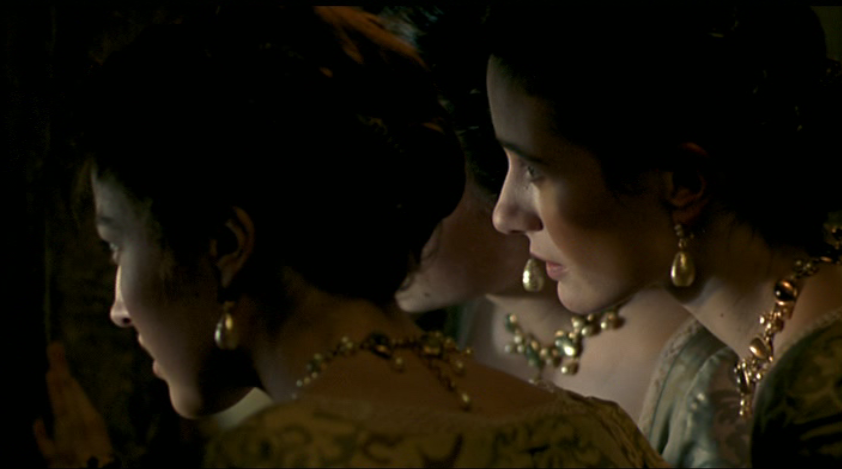
The Film: Kat Ashley is Elizabeth’s chief lady in waiting, supervising the other ladies and helping Elizabeth conduct her affair with Dudley by hiding his presence in her chambers from Cecil. Kat and Isobel Knollys are with Elizabeth through her imprisonment, the latter taking a fancy to Dudley and later having an affair with him. When meeting Dudley one night, Isobel dresses in one of Elizabeth’s gowns which results in her death when it turns out to be poisoned. A third lady is Lettice Howard, who is one of Queen Mary’s chief ladies and remains at court under Elizabeth. The Duke of Norfolk keeps Lettice as a mistress and she keeps him supplied with information about the Queen. Later, Lettice betrays Norfolk by delivering written proof of his treason to Walsingham.
In History: Kat Ashley was Elizabeth’s chief lady, but she was much older than portrayed in the film; she was a mother figure to the Queen rather than a younger friend. She did not cover up Elizabeth’s affair with Dudley and went as far as to beg the Queen to put him aside when rumours of an affair began to circulate.
Isobel Knollys and Lettice Howard didn’t exist per se, but there was a Lettice Knollys. Historically she was a lady in waiting to Elizabeth before leaving court to marry the Earl of Essex. Later, she married Robert Dudley in secret and earned the Queen’s enmity for the rest of her life. The character of Lettice Howard was invented for the film; the Duke of Norfolk did not keep a mistress at court and prominent ladies at Mary’s court did not generally transfer into the same position under Elizabeth. Also, no one died of a poisoned dress.
The Other Bits
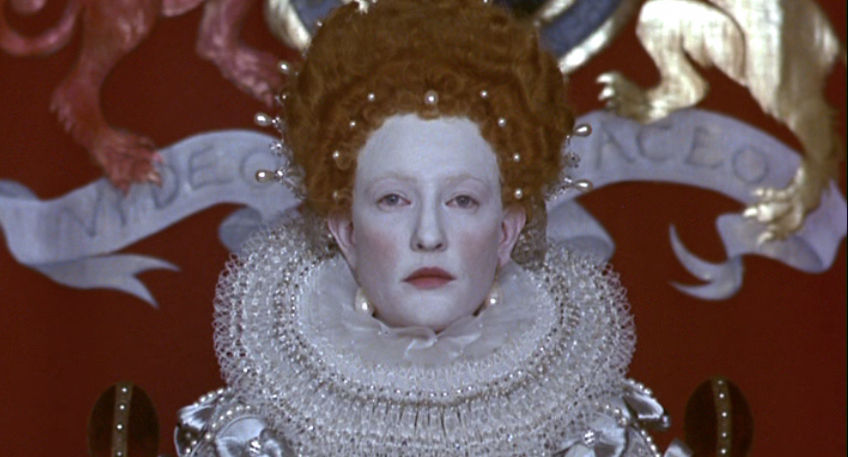
Bishop Gardiner says that Anne Boleyn was killed for her religion – in reality, she was charged (rightfully or wrongfully) with adultery and executed, her religion played no part in her downfall.
Elizabeth was crowned by Bishop Gardiner and Norfolk – As a layperson, Norfolk wouldn’t have had a presiding role in the coronation and Gardiner had been dead for three years at the time of Elizabeth’s coronation. The coronation would normally have been presided over by the Archbishop of Canterbury, but it’s most recent incumbent, Reginald Pole had died the same day as Queen Mary. Most of the bishops in the land declined to crown Elizabeth on account of their conflict in beliefs, those that remained were too ill to give an answer one way or the other. In the end, she was crowned by the Bishop of Carlisle who had already angered her by elevating the host at the Christmas mass. He accepted the invitation to preside at her coronation, but elevated the host again, causing the queen to walk out of her own coronation.
England and France went to war shortly after Elizabeth’s accession – they did not.
While on the Thames, Dudley proposes to Elizabeth through the poem, ‘my true love hath my heart’. – Although in the ‘making of Elizabeth’ the screenwriter attributes this poem to Thomas Wyatt, it was actually written by Dudley’s nephew Philip Sidney decade after Elizabeth came to the throne. At the time shown in the film, Sidney would have been an infant of four, and so probably not up to composing great works of poetry.
Elizabeth becomes ‘Gloriana’ shaving her head, pasting on white makeup and dressing as a virgin ruler to begin England’s golden age – Elizabeth’s use of heavy white makeup was more to disguise scarring after her bout of smallpox, four years into her reign. The same illness thinned her hair and so she started wearing wigs, initially to disguise the loss and later to hide her grey colouring. The Golden Age was also not something that came about until about thirty years into Elizabeth’s reign with the defeat of the Spanish Armada.
If you’d like to join me for more fun and games in picking apart history, and other behind the scene tangents, you can support me via my Patreon.

